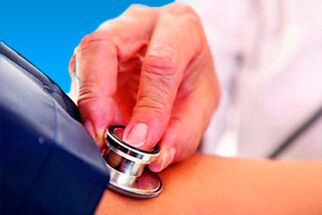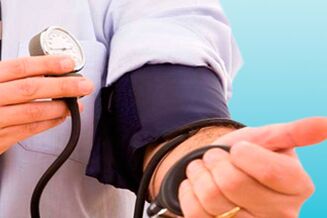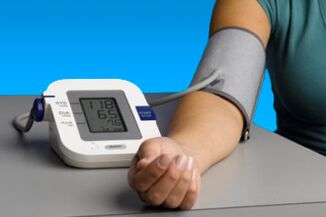
Infringement of blood pressure causes failures from the whole body. Despite the fact that this disease cannot be completely healed, the course of the disease may be less noticeable and problematic for the patient.
Michen Organs
Hypertension is a chronic disease that is associated with increased pressure within the vascular walls. In this case, it is very important to distinguish between rare situations when a person increases the pressure and the actual manifestation of this disease. An increase in time can occur for several reasons and usually does not repeat it soon. The cause may be a person's emotion, hormonal malfunction or injury.
Asking the question about what hypertension is, it is necessary to deal with the term "hypertension". This is a temporary increase in blood pressure above 140/90. But hypertension in medicine is called a condition in which a person has stable indicators. They rarely fall below these numbers on their own.
The negative side of this disease is that not only the cardiovascular system suffers from chronically high pressure. In medicine, there are organs -Eight. The essence of the problem is that constantly increased blood pressure has a negative effect on various organs - the heart, the kidneys, the brain and the retina. The disease will negatively affect the whole body, but they suffer first. Until the principle of disease classification depends on which body a negative effect was exercised.
Disease stages
The disease has several forms that depend on which principle classify. They may depend on the origin, course and blood pressure level. The easiest form of hypertension is easier as patients can discover their pressure at home.
Like other diseases, the development of hypertension has several degrees that only aggravate without the necessary treatment. There are standards that help determine the stage of the disease. You cannot draw conclusions after one or two measures of a person's pressure as this approach can provide incorrect indicators. If a person before that took certain medications or there was an emotional increase, and there were no bad or good emotions, the indicators may change. This will not allow you to see the real image of the patient's health.
Do not confuse the high pressure, which is within the normal range, with the manifestation of hypertension. The 120/80 pressure is considered normal for the human body, but the pressure can also be classified as 129/84. The pressure is considered increased to 139/89, but is not classified as a degree of hypertension. Hypertension is considered a pressure that exceeds 140/90.
Table 1. Degree of hypertension and pressure level
| The degree of hypertension | Indicators |
|---|---|
| Standard | From 120/80 to 139/89 |
| 1 degree of hypertension | From 140/90 to 159/99 |
| 2 degree of hypertension | From 160/100 to 179/109 |
| 3 degree of hypertension | 180/110 and above |

In addition to the definition of "hypertension" and the classification of the disease according to the degree of development, there is also a unit for primary and secondary hypertension. The primary develops as an independent pathology and often other problems in the human body have not been found in this case. If we are talking about secondary hypertension, this becomes the result of diseases in the human body.
The first degree
It is considered a light form of the disease, blood pressure indicators do not exceed 160/100, and attacks, especially without serious consequences. Hypertension of the 1st degree is characterized by spasmodic disorders that occur in the work of the heart. Periods of exacerbation can hardly be called rare, but due to a small manifestation and chronic course of the disease, they are suffered by the patient quite easily. Exacerbation alternates with normal indicators, during this period the patient does not feel the symptoms of the disease.
To properly assess the situation, pressure measurements are required using a tonomer several times a day. This is usually done three times a day in the absence of emotional gusts or other reasons that may affect a short -term change in blood pressure.
Hypertension of the 1st degree has its own symptoms, which patients often cannot seriously perceive. The disease can manifest with headache, rapid heartbeat or left side pain in the sternum. Often patients are confused by the fact that first degree hypertension is rarely characterized by symptoms.
But even a small degree of hypertension may have its own complications, which are full of serious disorders in the human body. That:
- Brain microinfarcts;
- Cardiac muscle hypertrophy;
- nephrosclerosis.
It is mistaken to suppose that 1st degree arterial hypertension can pass without tracking if treated with medicines. It can be argued that a patient who suffers from first degree hypertension has a risk of complications. Statistics indicate approximately 15% of such probability.
When the patient was diagnosed with 1st degree hypertension, the situation is as follows: high pressure can be triggered by narrowed gaps in the vessels, which leads to insufficient nutrition of bodily tissues. In the absence of a normal amount of nutrients and oxygen in cells, necrosis develops. Initially, this process is not noticeable, but over time, some organs in the patient's body, not just certain cells, can occur over time. Lack of treatment causes ischemic stroke.
If the patient has high blood pressure, even 1st degree hypertension has a very high risk of developing heart problems.
The change of indicators in the larger direction provides an additional load in the heart, which, trying to push the blood through the narrow gaps of the vessels, is overloaded. Everyone knows that, with additional load, the muscles begin to grow, this also happens with heart tissues. It may seem that hypertension of the 1st degree risk reduces the risk because the heart may pump more blood, but this is not totally true. Cardiomyopathy can squeeze the nearby vessels and even cause death.
The second degree

In the second degree of hypertension, the patient will be at the level of up to 180/110 mm Hg. In this case, patients in patients are much larger than with 1st degree hypertension, the risk of complication in which it occurs with less frequency.
The second degree of hypertension is characterized by the fact that the pressure is extremely rarely normal, can decrease and increase, but not reach the allowed limits. Usually, 1st degree hypertension is in danger of moving to the same disease of the 2nd degree, so it is possible to determine the appearance of benign or malignant arterial hypertension. Clarify what kind of hypertension has, what it carries and what risks arise helps the development of pathology.
In patients, vascular deficiency, head pulsation, hyperemia, problems with vision visuality and hypertensive crises are added to familiar symptoms. The problem with the latter is that the pressure can dramatically change in 59 units, which negatively affects the patient's body. In the second degree of hypertension, complications are possible:
- cerebral thrombosis;
- Aorta aneurysm;
- atherosclerosis;
- Angina Pectoris;
- Encephalopathy.
The peculiarity of this degree of development of hypertension is that the defeat of the target organs occurs. In patients with this diagnosis, bleeding is possible in one of the organs. This is due to the fact that, to a posterior degree of hypertension, blood vessels lose their old elasticity and can be much easier to collapse. There are also serious risks of blood clot formation in the walls of the blood vessels, the lumen in which it is already reduced.
Due to serious problems that may occur in the second degree of hypertension, the patient may receive disability. Most of the time they give 3 groups. But that does not mean that it is sufficient for the patient to measure his pressure several times and show that it exceeds the allowed norm. The commission takes into account the complications that emerged against the background of this disease, collects information on hypertension, as well as about the patient's working conditions - only after that can we talk about receiving a cash benefit.
The commission takes into account the complications that emerged against the background of this disease, collects information on hypertension, as well as about the patient's working conditions - only after that can we talk about receiving a cash benefit.
The paradox of the situation is that some patients try to get this help from the first symptoms, while others, on the contrary, hide their illness. Most of the time, this is done by employees who can be dismissed due to working conditions that are based on after that (more medical license, an increase in annual license). But we must not forget that, in the second degree of hypertension, an additional load may have serious consequences that will quickly aggravate the disease.
It is worth noting a possible special case in the second degree of arterial hypertension. When it comes to malignant pathology, the commission may assign 2 disability group. Men over 60, women over 55, as well as patients with irreversible defects, found inability to life. This means that there will be no need to approve the committee annually to confirm the status.
The third degree
By a person's pressure, the degree of disease can be determined. When indicators begin to reach extremely high rates - 180/110 mm Hg, the patient is diagnosed with a serious third degree of hypertension. In this case, the complications are very serious, most of them, with the premature provision of medical care, can lead to death. It can be a stroke, cardiac asthma, myocardial infarction, kidney failure and other diseases.
Evaluating the severity of this degree, patients receive 1 disability group. Evaluating the degree of risk of disease development, the patient should do no failure rehabilitation. There is no need to talk about treating this degree, but this approach will help to avoid premature death.
There is a concept of fourth degree hypertension. In this case, it is quite difficult for a person to help, because he is practically on the brink of death. Medicines help relieve symptoms and markedly reduce the pressure level. Hypertonic crises are pronounced and very frequent.
The degree of risk
Usually, by diagnosing the patient, the degree of illness and risk is indicated. This indicator can affect age, sex, obesity, bad habits and other factors.
There are four degrees of risk. The most ideal hypertension of 1st degree risk 1 is considered, the likelihood of developing side diseases is low to 15%. 1st degree arterial hypertension (risk 2) is one of the most popular diagnoses. This is due to the fact that few patients carry such a lifestyle that would not complicate the disease. When 1st degree arterial hypertension is diagnosed (risk 2), the probability of complications ranges from 15% to 20%.
The risk of 3 degrees is 20 to 30% probability of disease development. It is called high. There are also 4 degrees when the probability of developing pathologies exceeds 30%. All predictions of the degree of risk are calculated for the next 10 years in the absence of changes in the patient's lifestyle.
Depending on the injury of the patient's internal organs, doctors indicate the stages and the degree of hypertension due to indicators. It is the stage of the disease that determines which organs were damaged.
The 1st stage of the disease, in fact, has no indicators, because only an increase in pressure occurs and the human organs are not damaged. With the hypertension of the 1st stage, the patient will have optimistic predictions for the future.
In 2 stages of the disease, the first signs of vessel narrowing, plates appear and creatinine in the blood plasma increases. All changes that occur in the internal organs usually have no serious changes and, with proper treatment, complications can be avoided.
Unlike the second stage, the third is characterized by specific diseases, not just partial changes. This is pronounced hypertension, which means that in patients the risk of transferring myocardial infarction, stroke, the appearance of heart and kidney failure and other characteristic diseases increases several times.
Disease characteristics

Hypertension is common worldwide and is more common in highly developed countries. First of all, this is due to the fact that active life implies communication with a large number of people, and this implies different, bad and good emotions, which leads to constant peaks of pressure.
For many, it is not even difficult to answer the question of what it is? The prevalence of the disease makes it possible to call this 21st century Prague pathology. There is something like arterial hypertension syndrome, it is chronic vascular deficiency, the same hypertension. It is violations in the work of ships that cause hypertension syndrome.
Gestational arterial hypertension is extremely negative for a woman. The emergence of this pathology is associated with pregnancy, a woman during this period is against -in the take on most medicines.
At the same time, lack of treatment can have extremely negative consequences. Statistics show that gestational arterial hypertension is the cause of about one third of cases of mother's fatal outcome during childbirth, and can also cause the death of the fetus or premature birth.
In addition to the fact that the patient knows the symptoms of hypertension and what it is, it is necessary to contact the hospital in time, because the treatment of the disease is much easier in the first stage. It is necessary to consult the assistant doctor about increasing the dose or involving other medications. Self -mate can aggravate the disease.























